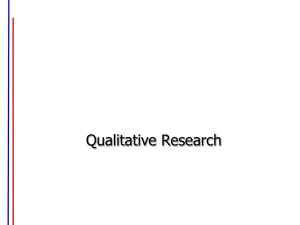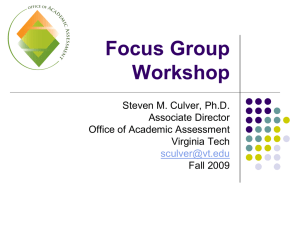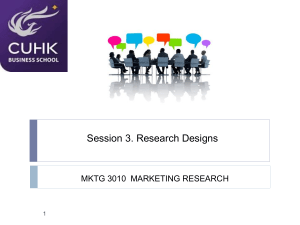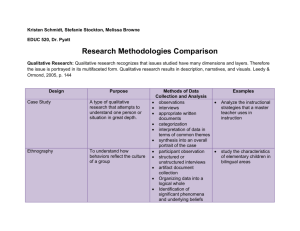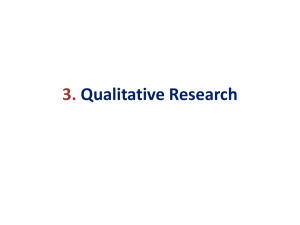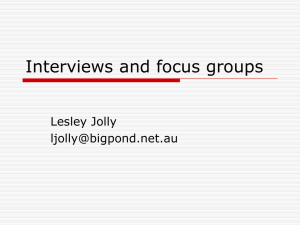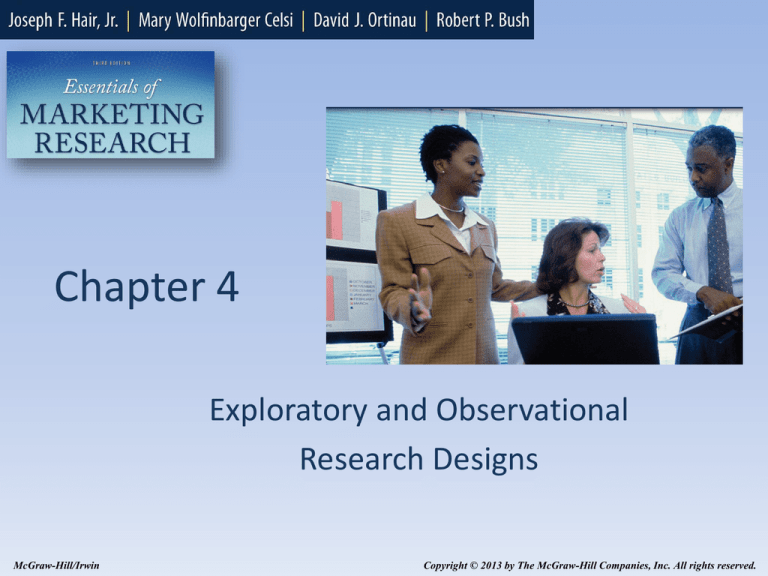
Chapter 4
Exploratory and Observational
Research Designs
McGraw-Hill/Irwin
Copyright © 2013 by The McGraw-Hill Companies, Inc. All rights reserved.
Overview of Research Designs
• Three major types of research designs:
– Exploratory
– Descriptive
– Causal
• Each type of design has a different
objective
– Though all three designs can be used in a
single study if appropriate: Called a
“Mixed-methods Design”
4-2
Overview of Qualitative and
Quantitative Research Methods
• Quantitative research: Places heavy emphasis
on using numeric data obtained from
• formal questionnaires or surveys administered to
large numbers of responders
• Any other numeric source of data (i.e. secondary
data)
• Qualitative research: Collection of data in the
form of words or images using open-ended
questions, observation, or “found” data
4-3
Value of Qualitative / Exploratory
Research
• Exploratory research designs are used when the
research objectives are to:
–
–
–
–
Gather background information
Clarify the research problems
Create hypotheses or establish research priorities
Probe more deeply into areas that quantitative research
(i.e. descriptive or causal research) is unable access – i.e.
subconscious processes, mental processes
– Provide initial ideas about specific problems, theories,
relationships, variables, and scale designs
• Results may or may not be sufficient for final decision
making (usually they are not)
4-4
Major Differences between Qualitative and
Quantitative Research Methods
4-5
Advantages and Disadvantages of
Qualitative Research
4-6
In-Depth Interviews
• A data-collection method in which a welltrained interviewer asks a participant a set of
semi-structured questions in a face-to-face
setting
– Discover subjects’ feelings, beliefs, opinions and
why they exist
– Encourage subjects to communicate as much
detail as possible
– Ensures privacy so as to foster optimal response
tendencies
– Helpful in generating new research ideas
4-7
Steps in Conducting an In-Depth Interview
Understand initial questions/problems
Create a set of research questions
Decide on the best environment for conducting the interview
Select and screen the respondents
Respondent greeted, given interviewing guidelines, and put at ease
Conduct the in-depth interview
Analyze respondent’s narrative responses
Write summary report of results
4-8
Focus Group Interviews
• A qualitative data collection method
• Responses to open-ended questions are
collected from a small group of participants
who interactively and spontaneously discuss
topics of interest to the researcher
– Bulletin board: An online research format in
which participants agree to post regularly over a
period of four to five days
4-9
Objectives of Focus Groups
• Helps establish or refine research needs, objectives and
questions
• Reveals consumers’ “hidden” attitudes towards brands,
companies, products, ads, etc.
• Generate new ideas for products, promotion, market
opportunities and any aspect of marketing strategy
• Discover new constructs and measurement methods
• Explain changing consumer preferences
• Observe consumers’ reactions to product prototypes
4-10
Focus Group Characteristics
•
•
•
•
•
•
8-12 participants plus moderator
Session lasts 1 – 2 hours
Respondents paid $50-$200
Typically held at FG facility
Participants pre-screened
Overall cost $2000-5000+ per group
4-11
Three-Phase Process for Developing a
Focus Group Interview
4-12
Focus Group Interviews
• Focus group moderator: A person who is well
trained in the interpersonal communication
skills and professional manners required for a
focus group
• Moderator’s guide: A detailed outline of the
topics, questions, and sub-questions used by
the moderator to lead the focus group session
(also called a “Questioning Route”)
4-13
Focus Group Interviews
• Debriefing analysis: An interactive procedure
in which the researcher(s) and moderator
discuss the subjects’ responses to the focus
group questions.
• Content analysis: The systematic procedure of
grouping individual responses into larger
themed categories or patterns and then
uncovering relationships among those
categories or patterns.
4-14
Advantages of Focus Groups
• Stimulate new ideas, thoughts, and feelings
about a topic – foster “group discussion
synergies”
• Elicit a wide range of responses and
differences of opinion
• Bring together hard-to-reach informants by
other means
• Good format for prototype or other
audiovisual demonstrations
4-15
Weaknesses of Focus Groups
• Findings lack generalizability to the target
population
• Reliability of the data is limited
• Trustworthiness of the interpretation is based
on the care, skill and insightfulness of
researchers analyzing the FGI data
• Groupthink: A phenomenon in which one or
two members of a group state an opinion and
other members of the group are unduly
influenced
4-16
Focus Group Interviews – Some General Guidance
•
•
•
•
•
•
•
•
•
Be nice, fun and accommodating – a sense of humor usually helps!
Proceed in phases (see Focus Group text)
Offer snacks or even a meal
Communicate ground rules upfront
Don’t be judgmental
Moderator can interject his/her POV – but do so judiciously
Prevent monopolization and groupthink
Solicit a reasonable amount of dissent and disagreement
Let the conversation evolve naturally, but be ready to re-direct errant
conversation back to the intended place
• Questions will almost always be answered out of sequence. May need to
skip, modify or re-visit questions as the session proceeds. Flexibility is
key!!
4-17
Ethnography
• A form of qualitative data collection that
records behavior in natural settings to
understand how social and cultural influences
affect individual behaviors and experiences
– Participant observation: Researcher observes
while participating in events
– Nonparticipant observation - Researcher
observes without participating in events
4-18
Case Studies
• An exploratory research technique that
intensively investigates one or several people,
groups or situations (though usually n=1!)
• Tracks thoughts, feelings and behaviors of the
same individual(s), group(s), or organization(s)
• Uses multiple interviews over several weeks
• Can tap into subconscious thinking and study withingroup interactions over time
• Why use case studies?
4-19
Projective Techniques
• An indirect method of questioning that enables a
subject to project beliefs and feelings onto:
– a third party
– a task situation
– an inanimate object
• Can be used in conjunction with focus groups or
in-depth interviews
• Major Advantage: De-personalization
• Major Disadvantage - Complexity of
interpretation
4-20
Projective Techniques
• Word association test: A projective technique in which
the subject is presented with a list of words or short
phrases, one at a time, and asked to respond with the
first thought [word] that comes to mind
• Sentence completion test: A projective technique
where subjects are given a set of incomplete sentences
and asked to complete them in their own words
• Zaltman Metaphor Elicitation Technique (ZMET): A
visual research technique used in in-depth interviewing
that encourages research participants to share
emotional and subconscious reactions to a particular
topic
4-21
Word Association
Which words come to mind when I say …?
•
•
•
•
•
•
•
Ice Cream
Adidas
Desk
Education
Apple
Party
Cosmetics
4-22
Sentence Completion
A person who wears Tommy Hilfiger shirts is _____.
People who fly Delta Airlines are ______________.
4-23
Cartoon Completion
Let’s get some
clothes from
Macy’s!
4-24
Thematic Apperception Test
Write a story about this image.
4-25
ZMET Technique
– Create a collage that expresses your feelings and
opinions about…
4-26
Observational Methods
• Used by researchers to collect primary data about
human behavior and marketing phenomena
without a formal research design
• Systematic observation of behavioral patterns of
people as they interact with other people,
products, events, and various other marketing
stimuli
• Requires
• An observable phenomenon
• A system of observing recording the actual observations or a
facsimile thereof
4-27
Characteristics of Observation
4-28
Two Types of Observation Methods
– Technology-mediated observation: Data
collection using some type of mechanical device
to capture human behavior, events, or marketing
phenomena (i.e. a camera or video recording
device)
– Scanner-based panel: A group of participating
households that have a unique bar-coded card as
an identification characteristic for inclusion in the
research study
4-29
Eye-Tracking Technology
4-30
FMRI: Functional Magnetic Resonance Imaging
4-31
EEGs - Electroencephalography
4-32
Selecting the Observation Method
• Answer the following questions:
– What types of behavior are relevant to the research
problem?
– How much detail of the behavior needs to be recorded?
– What is the most appropriate setting (natural or artificial)
to observe the behavior?
– Is a setting available to observe the behaviors or events?
Is it practical?
– To what extent are the behaviors or events repetitious and
frequently exhibited?
– What degree of directness and structure is needed to
observe the behaviors or events?
– How aware should the subjects be that their behaviors are
being observed?
4-33
Benefits and Limitations of Observation
Benefits
• Accuracy of recording
actual behavior
• Well-controlled
experimental
environments in “lab”
studies
• Provides detailed
behavioral data
Limitations
• Difficult to generalize
findings due to small
sample sizes
• Cannot explain
behaviors ( i.e. the
“why?”) and mental
processes
• Ethical issues
4-34
Purposed Communities
• Purposed communities: Online brand
communities that can be used for research
– For example, MyStarbucksIdea.com is a brand
community whose primary focus is producing new
ideas
– Can also be used to track backlash emanating
from anti-brand communities (ihatewalmart.com,
rachelraysucks.com)
4-35
Social Media Monitoring and the
Listening Platform
• Social media monitoring: Research based on
conversations in social media
• Listening platform/post: An integrated system
that monitors and analyzes social media sources
to provide insights that will support marketing
decision making
• Sentiment analysis/opinion mining: The
application of technological tools to identify,
extract, and quantify information contained in
textual social media data
4-36
Netnography
• A research technique that requires deep
engagement with online communities
• Researchers:
– Gain entry into the community
– Gather and analyze data from members of the
community
– (sometimes) Ask for feedback on the research report
from members of the community
– Avoid biasing behavior or creating ill-will through
participation or observation
4-37

